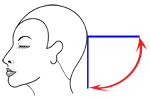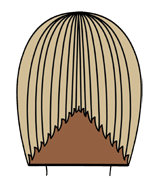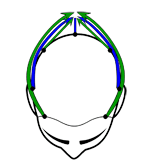Principles of Shape
Principles of Shape
THREE TYPES OF MOVEMENT
1. ELEVATION
All hair design can be simplified into two types of haircuts: blunt or graduated/layered. If you don’t want the hair to be blunt, you must lift it or pick it up. Elevation is an up and down movement. To elevate the hair, take a section in an upward manner without moving it from its natural falling position. After you cut the hair and let it drop, it will fall down vertically with no side-to-side movement. What it Creates
Elevation creates graduation; a finished hair design is either one length or it has graduation/layers in it. To help you remember the movement of elevation, think of an elevator. It moves up and down, not side to side. If you want the hair to fall directly back to its natural falling position after you cut it, the client’s head must be upright. If the head is pushed forward, the hair is not in its natural falling position. If you are doing a shape that requires the hair on the entire head to be elevated horizontally, make certain that all sections are elevated at the same angle for consistency.
2. OVER DIRECTION

The movement of over direction is side-to-side. If the hair is moved out of its natural falling position in a side-to-side motion, it is over directed. If you take hair from the back of the ear and direct it to center back, this is a side-to-side motion.
What it Creates
Over direction creates length and width in the opposite direction. If hair is directed from the front to the back, hair is longer in the front. If hair is directed from back to front, hair is longer in the back.
3. FINGER ANGLES
The movement of finger angle is in and out. The fingers determine the angle at which the hair is cut. If you want to adjust the volume or depth within the shape, you adjust your fingers or finger angle. Working with Finger Angles
Finger angle creates the placement of volume or depth within a shape. Viewing your finger angle from the front, if you place your fingers in the side area and angle them diagonally IN at the chin and OUT from the top of the head, the volume would be at the top of the shape. What would happen if you changed your finger angle? In this instance, your diagonal finger angle is reversed. Now your fingers are OUT from the chin and IN at the top. The volume would be at the bottom.
CONCLUSION
Even though we think about elevation first, over direction second and finger angle third, they don’t happen independently—they happen simultaneously. You wouldn’t elevate the hair up, over direct it to the side and then try to move your fingers in at the proper angle; you would lose control of the hair and the results would be unpredictable. To achieve predictability in the shape and precision in the line of graduation, we apply the movements at the same time."
Principles of Shape
Principles of Shape
THREE TYPES OF MOVEMENT
1. ELEVATION
All hair design can be simplified into two types of haircuts: blunt or graduated/layered. If you don’t want the hair to be blunt, you must lift it or pick it up. Elevation is an up and down movement. To elevate the hair, take a section in an upward manner without moving it from its natural falling position. After you cut the hair and let it drop, it will fall down vertically with no side-to-side movement. What it Creates
Elevation creates graduation; a finished hair design is either one length or it has graduation/layers in it. To help you remember the movement of elevation, think of an elevator. It moves up and down, not side to side. If you want the hair to fall directly back to its natural falling position after you cut it, the client’s head must be upright. If the head is pushed forward, the hair is not in its natural falling position. If you are doing a shape that requires the hair on the entire head to be elevated horizontally, make certain that all sections are elevated at the same angle for consistency.
2. OVER DIRECTION

The movement of over direction is side-to-side. If the hair is moved out of its natural falling position in a side-to-side motion, it is over directed. If you take hair from the back of the ear and direct it to center back, this is a side-to-side motion.
What it Creates
Over direction creates length and width in the opposite direction. If hair is directed from the front to the back, hair is longer in the front. If hair is directed from back to front, hair is longer in the back.
3. FINGER ANGLES
The movement of finger angle is in and out. The fingers determine the angle at which the hair is cut. If you want to adjust the volume or depth within the shape, you adjust your fingers or finger angle. Working with Finger Angles
Finger angle creates the placement of volume or depth within a shape. Viewing your finger angle from the front, if you place your fingers in the side area and angle them diagonally IN at the chin and OUT from the top of the head, the volume would be at the top of the shape. What would happen if you changed your finger angle? In this instance, your diagonal finger angle is reversed. Now your fingers are OUT from the chin and IN at the top. The volume would be at the bottom.
CONCLUSION
Even though we think about elevation first, over direction second and finger angle third, they don’t happen independently—they happen simultaneously. You wouldn’t elevate the hair up, over direct it to the side and then try to move your fingers in at the proper angle; you would lose control of the hair and the results would be unpredictable. To achieve predictability in the shape and precision in the line of graduation, we apply the movements at the same time."
